The "Data" pulldown menu:
Activating this button enables to enter or modify
crystal data by means of the following menu:
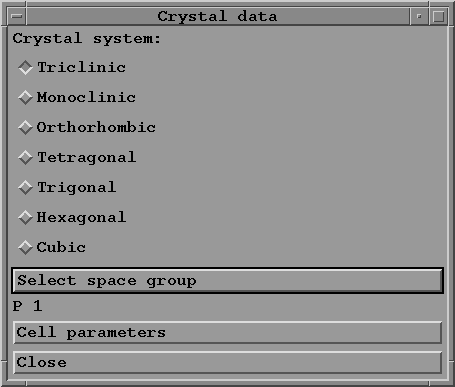
Select first the crystal system by
clicking on its name (for example Trigonal).
Press the "Select space group" button. This will
display a selection window:
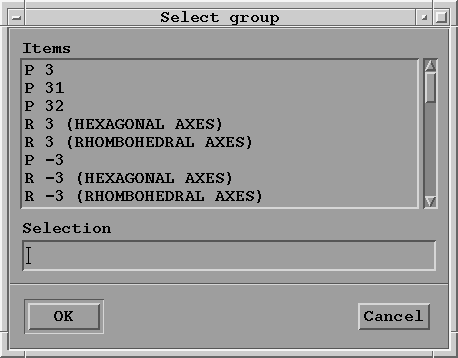
in which you may navigate with the vertical scrollbar on the
right. To choose a space group just click on its name;
then press the "OK" button.
Use the "Cell parameters" button. You must
enter the cell parameters in the sub-menu:

The unit is Angstrom for the length and degrees for the angles.
This button opens a menu which allows you to
give the position of the detector
(usually a photographic film):
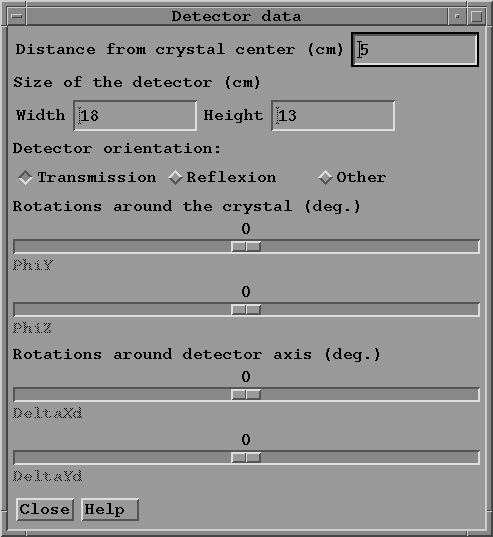
In the first box give the distance
from the center Od of the detector to the center O of
the irradiated zone.
For a simulation this distance may be
approximative, but for the indexation
of an experimental diagram it must be given
with the most accurate precision.
On the next line enter the width and the height of
the detector (in cm).
For conventional experiment just
select the "Transmission" or "Reflexion" button.
The cursors are desactivated, because they are
useless.
Otherwhise, select the "Other" button: this will activate the cursors.
In the apparatus axes (see paragraph on
set of axes) the
center of the detector is given by mean of two angles.
PhiY, is the rotation angle in degrees around
the OY axis; PhiZ
is the rotation angle in degrees around the OZ axis:

If necessary, the program also enables you to rotate
the detector
around its Xd axis by an angle DeltaXd given by
means of the third cursor (left drawing):


and then around its new Y'd axis by an angle DeltaYd given by
the last cursor (right drawing).
This button is only used when one wants to index an
experimental diagram. It displays the menu:
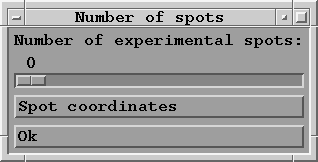
in whitch the cursor enables you to indicate the number
of experimental spots to be used during the
indexation (10 maximum).
Clicking the "Spot coordinates" button opens
the sub-menu:
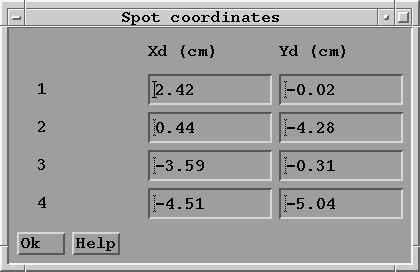
Give the coordinates (in cm) in the detector axes
(see paragraph on set of axes used) of experimental spots.
The first two must have low
Miller indexes. In the experimental diagram,
such spots are recognisable because they are
isolated and located at the intersection of zone lines (ellipses,
hyperboles or paraboles depending of the geometry of the
experiment).
For the indexation, the program uses the procedure
described in the papers of Riquet & Bonnet and of Laugier &
Filhol.
This button is usefull only when one wants to compute a simulation
taking into account spots intensity. It shows the
following menu:

where three kinds of X-ray sources are available:
an ideal source with a constant spectrum, that is
producing the same intensity for all wavelengths.
a conventionnal X-ray tube: when choosen, the
"Source characteristic" button opens a sub-menu
where one may give the voltage of the tube in kV.

The program will compute the intensity of the continous background
using the Kramers formula (see Preus publication),
but without taking into account the
characteristic lines.
other: in this case supply to the
program the spectrum of your X-ray source. This is done by clicking
on the "Source characteristic" button: this will direct you to a sub-menu
allowing you to read the file containing the spectrum. The format
of this file is described in the paragraph "Format of data files".











